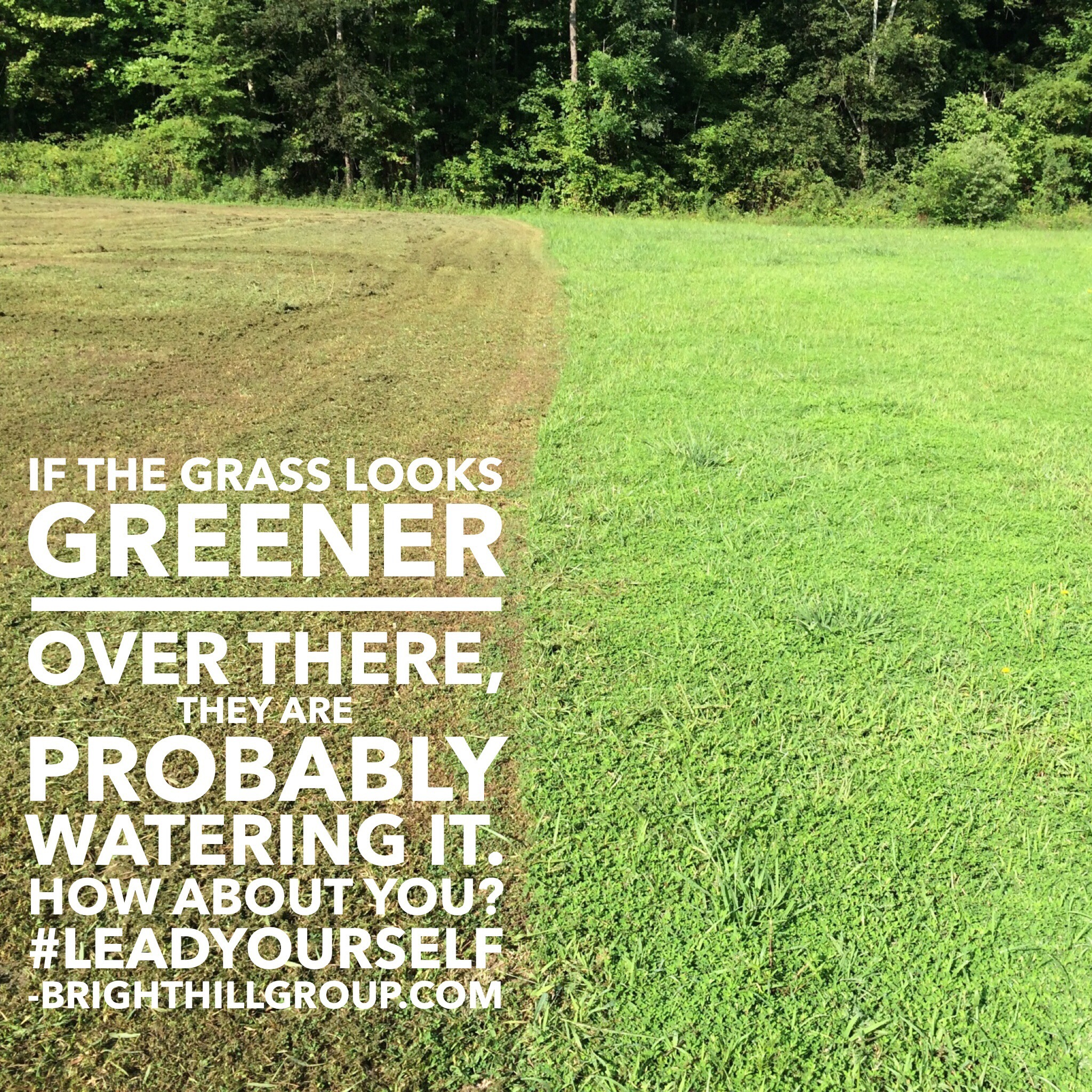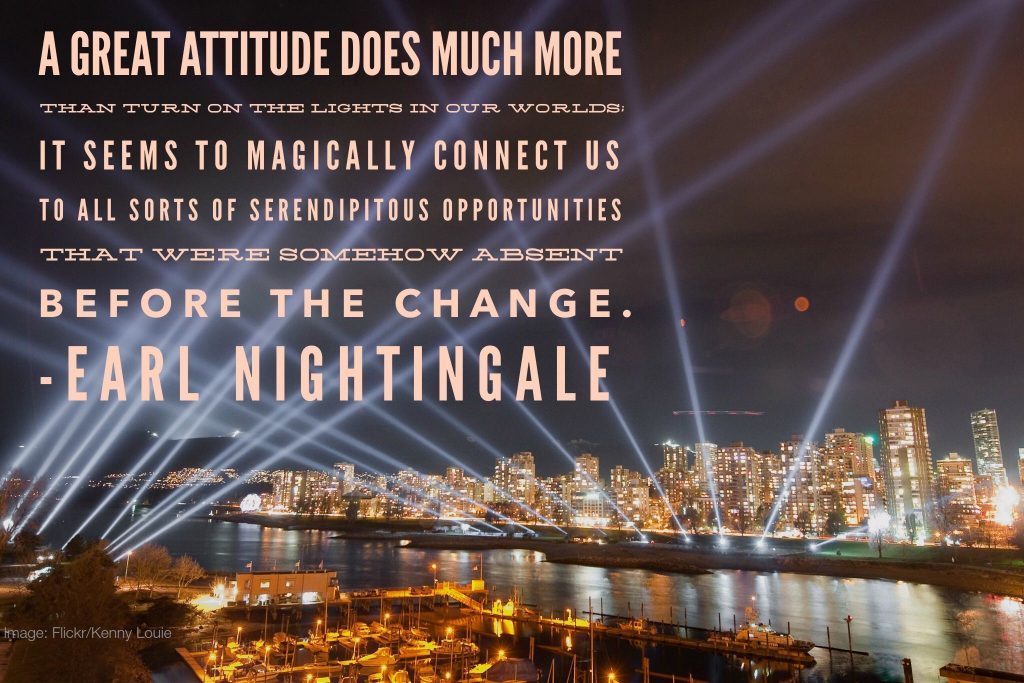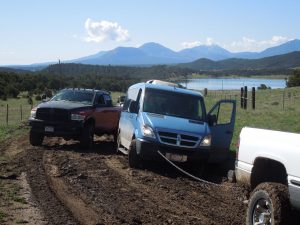<

If the grass looks greener over there, they are probably watering it.
What’s your plan for growth?
Make one!
#LeadYourself
Are you Eeyore? (& What To Do If You Are!)
Two points today:
1. Your attitude matters
2. You can change your attitude
What “color” is your attitude?
I spent part of my weekend repainting a room. The previous owners of my house had a room designated to be a media room, and had painted the walls, ceiling and trim a deep, dark blue. That seemed to be ideal – it removed all distractions from the “main attraction.”
I have an entirely different purpose in mind for that space, and I’m going with a much different color scheme.
As we began putting the first of a few coats of primer on the walls we began to notice something. The room was really transformed. It went from a dark, cave-like feel to an open, bright feel. The room felt bigger. The new paint reflected light and helped me see – even in the previously dark corner recesses!
It occurred to me that all too often our attitude at work is like that blue paint. Our darkness is so “normal” to us that we don’t even notice it. Those around us may think “That’s just the way he is.”
What is your attitude like? Are you sucking the light out of the room or reflecting light, possibilities and opportunities wherever you go?
My friend Ian Altman says “All people bring joy. Some when they arrive, others when they leave.” Which group are you in?
Are You Eeyore?
I used to work with a man I teased about being Eeyore. Those of you who read Winnie the Pooh may recall that Eeyore the donkey was a pessimist’s pessimist. Pooh’s Eeyore would say things like “I suppose that’s the sort of thing you like, if you like that sort of thing.” Eeyore simply could not find a positive in his circumstances.
My “Eeyore” was so negative that I believe if you handed him a $100 bill he would complain that it wasn’t $200, or that it really would have come in handy two weeks ago.
I have a funny story about Eeyore. His attitude was completely under his control. His attitude was a choice he made.
When my grandmother was no longer able to drive, she asked me to sell her car for her. It really was the used car driven by the little old lady who only drove it to the grocery store and church on Sunday. I knew that Eeyore was looking for a reliable car for his son to drive, and I asked if he might be interested in buying it.
One thing I know about cars. They need maintenance. There’s always a story to tell about a problem with them. Something breaks, wiggles, rattles or even falls off!
When Eeyore said he was serious about buying the car, I wrote up a contract. I knew I didn’t want to hear about that car after the sale. I also knew that Eeyore was, well, tight with a dollar. I wanted to protect myself, and I had a flash of brilliance.
The purchase agreement literally said “If the buyer ever complains about anything related to this car, he will immediately pay the seller $5 cash for each negative statement.”
When he saw it, he smiled broadly. He laughed loudly. He signed the contract.
You know what happened? He NEVER said a negative word to me about that car.
Eeyore drove that car for another 160k miles. For the next several years, every single time I saw him, he’d smile and make a point of telling me what a great car that was, and how it was working well for him. Every. Single. Time.
His complaining had become a habit, and he could choose to be positive. I’m sure that car needed all kinds of work over the years, but Eeyore never mentioned that to me – he focused on the good parts about it.
What is your attitude like? Are you Eeyore? Are you like that dark room?
How are you affecting others around you? What do you need to do differently?
2 Action Points
1. Say to a close coworker:
“As a part of my personal growth plan, I’m asking others for input. Be completely honest with me. I won’t get defensive or upset. I need this straight. When you think of me, how would you describe my attitude – positive, negative, neutral or something else?”
2. Don’t be Eeyore. Choose a positive attitude. Choose gratefulness. Choose to comment on the positive. Look for something positive to say today. Be intentional about it!
Our attitude affects our success.
“A great attitude does much more than turn on the lights in our worlds; it seems to magically connect us to all sorts of serendipitous opportunities that were somehow absent before the change.” – Earl Nightingale
5 Lessons I Learned While Stranding My Whole Family On A Remote Mountain Road
This last week I’ve been on a roadtrip with my family to visit my wife’s aunt and uncle in breathtaking southeastern Colorado.
One night I was walking around in the back yard and got my introduction to the local spring mud.
This stuff is THICK. The soles of my shoes were literally covered with about 2 inches of mud.
After leaving them on the front porch overnight it took a combination of beating them together, scrubbing with a scrub brush, and finally walking through tons of sand to clean the muck out of the crevices.
The Adventure Begins
One of the things my wife wanted to do while we were in this incredible part of our nation was get a view from high on a snow capped mountain peak. As we were planning our outings, we decided to visit the Great Sand Dunes national park.
As I looked at the map, there were 2 possible routes:
- 104 miles around the mountain on main roads.
- 30 miles passing directly over the summit of the mountain.
I chose option 2. This would be a major score – a fun run over the mountaintop to a beautiful place.
We struck out across the “county roads.” Here in Colorado these are gravel roads stretching for miles across the valleys. We navigated these unmarked roads, leveraging Google Maps. We found our way across our shortcut to the paved road. Bouyed by that positive experience, we happily turned off the paved road onto another county road headed toward the mountain top.
A Bad Decision?
A short way on this second set of rural roads we encountered some of that Colorado spring mud I mentioned above. The van slid through the sloppy stuff into the deep tire track ruts. As we plowed our way through the sticky mud, the Sprinter van’s traction control light flashed wildly on the dash as the on board computer worked madly to help the rear wheels find some grip.
I’ve driven enough in snow to know that you’re going to be in deep trouble if the vehicle comes to a complete stop going up hill.
No matter how hard I mashed the accelerator to the floor, the van’s computer and transmission overrode my commands in the hopes of not spinning the wheels.
I could feel the van slowing down, and I was getting nervous. Occasionally we would lurch forward a bit as we gained traction only to be shoved into the deep, adhesive mud.
My stress level increased as I could feel Holly’s anxiety increasing. I’m blessed with a wife who generally worries little and loves adventure. When she starts to get nervous, I know I’m in trouble.
As a guy, I want to be adequate – I want to be able to solve problems. I really wanted to please Hollly, and I had DECIDED to go this way, so my pride was on the line, too.
The van’s pace slowed more and more as we progressed up the hill. Inch by inch, we made it through the worst of it.
I felt a deep sense of relief as I watched the color of the road surface change from dark brown to a lighter tan as the dirt contained less and less water. Finally we hit dry enough dirt to shake some mud off the tires and proceed.
My anxiety level dropped a bit until Holly suggested
“Tom, maybe this is a bad idea. I wonder if we might get stuck here on this road…”
In my heart, I knew she was right. If I was willing to be honest with myself, I wanted to turn around – but have I mentioned that these roads are REALLY narrow? I just didn’t see any way I’d be able to turn the van around, and based on what just happened, I was terrified that I’d get stuck blocking the road. In addition, my pride was at stake, and I couldn’t admit defeat.
I defensively snapped back at Holly
“Look, we made it this far. There’s no way to turn around here, and I bet it’s going to dry out as we get further up the mountain.”
She didn’t like the idea and she didn’t like my response. The stress level went up – for both of us.
We kept going a few more miles – realizing just how remote this road really was – winding through the valleys and climbing higher up the mountain. The views were beautiful, and Holly said
“Gee, I bet no one uses this road at all.” Not very comforting.
About the time we passed the reservoir we hit another long slog of mud. I sped up to get a running start and the van jerked to a crawl as we dropped into the ruts in the road. Again the van’s traction control light flashed madly. This time, I completely lost control of my steering – no matter what direction I pointed the wheels, I was powerless to move the van left or right.
The van gradually slowed. Holly said
“Tom, are you slowing down on purpose?”
My adrenaline level peaked, my stress level hit 100% and I was scared. What had I done?
“OF COURSE I’M NOT SLOWING DOWN ON PURPOSE!”
Eventually, predictably the van stopped moving forward. I tried backing downhill a bit only to slide uncontrollably into the ditch on the side of the road. There was no question – this was it. I was not going to be able to get myself out of this one.
My wife and 7 kids were in the middle of NOWHERE because of my choices. As far as I could tell, we were about to be stranded, and it was all my fault. Worse than that, I was powerless to “fix it.”
Cell phones don’t work this far away from civilization. There was no good place to walk along this road – and the thought of leaving Holly and the kids while I walked miles to a stranger’s house to beg for help was NOT appealing.
I got out of the van to survey the damage. I was stuck. No doubt about it. NOW what was I going to do? I was going to have to admit I was wrong – admit it to myself and (more painfully) I would have to admit it to Holly.
What Are My Key Learnings From This?
- It’s a good idea to do some research before using a VERY remote road.
- When my wife offers input on rethinking a decision, I probably need to go along with her plan.
- My pride is less important than I think it is. Holly (and the kids) already knew I’d blown it – and I’d probably have been better off to “cut my losses.” It’s valuable for them to know that *I* know I’ve dropped the ball
- I’m naturally optimistic – and sometimes I bite off more than I can chew.
- I needed to apologize to Holly for snapping at her. My stress is no excuse to be rude to her.
So What Happened NEXT?
Thankfully, a few minutes after we got completely stuck, a group of off-road enthusiasts came by and offered to help us.
They generously hooked up a chain to the eye bolt I screwed into the tow point on the front of the van, and then the nice guy in the lifted Dodge 4×4 pulled Big Blue (our Sprinter) through the muck to the top of the hill to the ONLY decent turnaround I’d seen on the whole trip.
As I was getting towed out of my predicament, one of the folks helping informed me that the spring muds on that road get MUCH worse than that as you get closer to the summit, and there are 8 river crossings between where I was and the dunes. Some of the river crossings are 30″ (or more) deep!
(Perhaps #6 on my list above should be “don’t competely trust Google maps for navigation!”)
Thankfully we were able to slide our way downhill through the slimy sticky mud and back to the paved roads. We returned to our home base for a bathroom break, and then headed out “the long way” to the Great Sand Dunes.
The day was salvaged, and I’m glad to have picked up a few things from my experience.
Let Me Ask You
- Have you ever been in a place where you made a judgment call that turned out to be wrong and it left others hanging?
- Have you let your pride hang you out to dry?
- What did you do about it?
3 Things I Learned About Leadership When I Met The Duck Dynasty CEO
“Hey – You can’t park there. You idiot – can’t you see the signs? I’m trying to run a business here!”

Oh wait – that’s exactly NOT what Duck Dynasty CEO Willie Robertson said to me.
My kids love to watch Duck Dynasty. The show is a light-hearted silly look at a small business run by a bunch of fun-loving family guys who like to blow stuff up. It’s perfect for my teen and pre-teen boys, and it’s a favorite at our house.
We’re on a big family road trip and we passed through West Monroe LA – the headquarters of the Duck Dynasty business. Just for fun we decided to drop into the Duck Commander offices and visit the gift shop.
When we pulled up outside, we were shocked to see Willie Robertson, the “CEO” of the multi-million dollar family business standing outside greeting visitors.
Now Duck Commander is big business. These guys have patents on the design of duck calls – a big niche market. They also sell deer hunting related products. In addition, the family stars in a break out hit “reality” TV show, and recently sponsored a big NASCAR race – the Duck Commander 500.
As we pulled up in our enormous Sprinter van, we were stunned to see Willie standing outside shaking hands with fans.
Not wanting to miss our #BrushWithFame, and a photo op – I offered to drop off Holly and some of the older kids in the “no parking” area. When I stopped the van, Willie could have easily chewed me out, but instead he said
“Hi! That’s a pretty nice vehicle you’ve got there.”
Encouraged by Willie’s greeting, I put the van in park, got out and unbuckled my three year old.
JD – Willie’s assistant – took my camera from he he commented
“This is a big part of my job these days. I’m pretty good at it, now.”
As I worked on getting all of the kids to line up. I noticed that Willie talking to my 3 year old as my wife held Noah in her arms.
We spent just a few moments with him, but there are three takeaways I have about leadership from that encounter.
1. The “work” is more than the duck calls and TV program – it’s in the PEOPLE.
I’m sure that Willie had about a thousand things more “business related” than standing in the hot Louisiana sun shaking hands with fans.
As much of a goofy leader as he appears to be on the TV show, Willie knows that his success is tied to other people. He’s spending a LOT of time pressing the flesh and taking pictures with fans and guests. That’s as much his job as it is making sure that the duck call manufacturing is happening.
2. Even people who can’t directly help you are important.
Willie made it a priority to make a connection with my 3 year old. He asked him questions and smiled warmly at his answers.
Why? Because Willie even values people who cannot buy stuff from him.
(And Noah’s mom really likes it when people value her kids, too!)
3. “You’ve got to make hay while the sun shines”
During our brief connection, I mentioned his marketing strategy, and that’s how he responded. Willie knows his fame is fleeting, and he has to take action immediately to maximize his impact.
For Willie, “making hay” included taking the time to connect with us personally.
Think Willie’s strategy worked? We left the store with a big bag of souvenirs, and a great memory of getting a photo with him.
3 Reasons Your Strategic Plan Will Fail – (& One Sure-fire Way to a Winning Plan!)
When Strategic Planning is Broken
There are three common approaches to strategic planning.
All of them are a complete waste of time, money and effort.
Strategic Planning the Wrong Way – Option 1
Seriously. The biggest waste of money is no plan at all.
Strategic Planning the Wrong Way – Option 2
Today I’m reviewing a client’s proposed “strategic plan.”
Most of the time when I work with a client on this, their original plan looks a little like this:
 This one today is no different.
This one today is no different.
The “plan” is to have each department come up with a list of
- What they did last year
- What they will do next year
Each functional team creates a mind-numbing detail-filled PowerPoint deck which they will be given an hour to present during the “planning meeting.”
This one feels better than no plan at all, but it’s still a waste.
People work really hard to try to communicate status and plan, and yet they end up leaving everyone’s brain spinning with all the minute details of everything that each department thinks they will do if the stars align.
This simply does not work.
Strategic Planning the Wrong Way – option 3
This one is a favorite, too. We all get together in a room and
- “Seek enlightenment”
- “Throw away the box”
- “Blue Sky”
- “Anything is Possible”
This provides an interesting thought exercise, but a lack of structure leads to a “new, innovative strategy” but no action is taken. It’s a waste.
Research shows that 90% of all strategic planning efforts are a complete waste of money!
Does your strategy matter?
If your strategy doesn’t matter – let’s say you’re a goldfish, and your strategy consists of swimming in circles, then don’t worry about doing strategic planning.
If you’re not a goldfish, you probably want to make plan.
But… If the 3 most common approaches fail, what DOES work?
A great strategic plan includes
- A high level view – what’s the VISION for what we will accomplish?
- A refinement of what you’re already doing – what do we need to change to get from here to there?
- What PRIORITY will these new activities have relative to the rest of your work? What might you need to STOP doing to fit this in?
- A set of ACTION STEPS to take – SMALL, MEASURABLE STEPS, not big ones – If you’re a couch potato today, you won’t be running a marathon tomorrow – what can you REASONABLY accomplish given the current project load?
- An owner for each activity – WHO will do the work?
- A due date for when the owner will make progress – When will it be done?
- A success measurement – How will you know it worked?
- A plan to revisit the plan – SPECIFICALLY when will you regroup to check action against plan?
A strong tie to action is the key to successful strategic planning.
This can be hard, but it is completely doable!
ACTION POINT
You know you need a good plan, and you’re ready to take action. Here are 2 possible approaches
Option 1: Do it yourself
Take this list above and create the agenda for your strategic planning meeting
I have a client who invested in a strategic planning session. It REALLY worked. They worked better as a team and achieved a lot of the ideas that they had been thinking about.
The next year they said “We know what to do now. Let’s take the plan from last year and revise it. We’ll save all that consulting money we paid to the coach!”
Guess what? They didn’t “get around to doing the plan” and the next year, they had not made any progress. They knew what to do, and didn’t have the discipline to do it on their own.
For their upcoming fiscal year they have allocated budget dollars to get some help.
Option 2: Let me help you
I can help you
- Plan for your planning summit,
- Facilitate the discussions,
- Keep you on track,
- Document your:
- Decisions made,
- Priorities set,
- Owners,
- Deliverables,
- Due dates and create your accountability plan
Companies that succeed do it through a disciplined process.
Give me a call at 240-668-4799.
I’d love to help you move forward with more of this:
and less of this:
Want more information?
Action-Oriented Strategy
Or – you can find the full catalog of my services here:
"These people make me crazy! Why won't they get off their butts and do the simplest thing?"
 The Outburst
The Outburst
We were sitting around the convergence room table during the sales pipeline meeting when suddenly Gary exploded in response to something Frank said.
You told Jack WHAT? What the hell were you thinking!?!?! Why did you tell Jack we could help them with that? We don’t even DO that!
The profanity-laced tirade went on for several minutes. The tension in the room built as Gary unpacked his frustrations on a stunned Frank.
At first, Frank attempted to sputter a response. This seemed only to fuel Gary’s anger. Cowed by the personal attacks, eventually Frank settled into sitting in silence, enduring the tongue lashing he “deserved” for doing something that Gary thought was stupid.
This was not the first time this had happened. I, too, had been the recipient of one of Gary’s attacks. It was awful. Every. Time. Awful for the target and for each of us around the table. Based on our experience, we recognized that the fastest way to bring it to a close was to sit down, shut up, and hang on.
After Gary unloaded, it was over for him, and he returned to work as if nothing unusual had happened.
Observations
- Conflict was seen as bad: Gary was not comfortable with conflict. He had expectations of people on his team. Of course, he did not consistently (or clearly) communicate those expectations to others.
- Since team members didn’t know what he wanted, they were unable to meet his expectations. They guessed, experimented, tried, and far too often they failed to do exactly what he would have done in that situation.
- Gary would notice that performance was not as he expected. He would be frustrated and begin to stew on the “failure.” This frustration would churn around and get bigger.
- Gary would confide in a team member that he was upset with the other team member. He would way “I don’t know why he did that. I was CRYSTAL CLEAR about what I wanted him to do.” (No, Gary was NOT crystal clear with others. Seriously.)
- He would continue to be frustrated about it until he hit his limit and he would “unload” on the person who “dropped the ball.”
- His demons exorcised, Gary felt better and could return to “normal.” He was “fine.”
- What about the team? We were left shell shocked. We could not predict when this might happen, or to whom. We walked on eggshells around him. All the time.
We could not be certain whether Gary would approve or reject our ideas, and we didn’t feel safe asking for his input because we could not predict whether he might unload on us. If we got great results, Gary was usually thrilled. (Sometimes he didn’t seem to notice or care.) If our results didn’t come – or didn’t come fast enough – he would sometimes be supportive, other times he would be furious. We could never tell what would happen.
Should I have had the moral courage to stand up to Gary? To tell him the truth? Perhaps. Should I have quit? Probably. Frankly I was afraid of him. He controlled my livelihood. If he wanted me gone I would immediately move to the ranks of the “unemployed.” My wife and kids depended on his whims.
As a result I rarely challenged him, rarely spoke up. I played it safe. So did almost everyone else. He didn’t see that. At all.
The really sick part was that Gary asked me over and over again why he could not motivate people to “get off their butts and take initiative.” He was sincere, but not ready to hear the answer.
He really saw no connection between his occasional eruptions and the impact on team members. It was a sad thing.
It was sadder still because at the core, Gary was a decent guy. He was passionate about his business and about his people. Gary really cared about team members as people, and it tore him up to see them struggling through personal issues.
Gary simply didn’t see the pain HE caused.
Does this ever happen in your workplace?
- Do you ever yell at your people?
- Does your boss ever “back up the truck and dump a load” on people to “drop the ball?”
- Do you ever wonder why people don’t take initiative or try new things?
This problem is solvable. Working together, we can help people begin to build a safe, productive, trustworthy environment. You’ll be amazed at how much faster work can get done. How much more innovation can happen.
Do your people make you nuts? Want to talk about it? Give me a call. If I can help, we can talk about next steps. No obligation, no sales pitch. Just a listening ear.


















